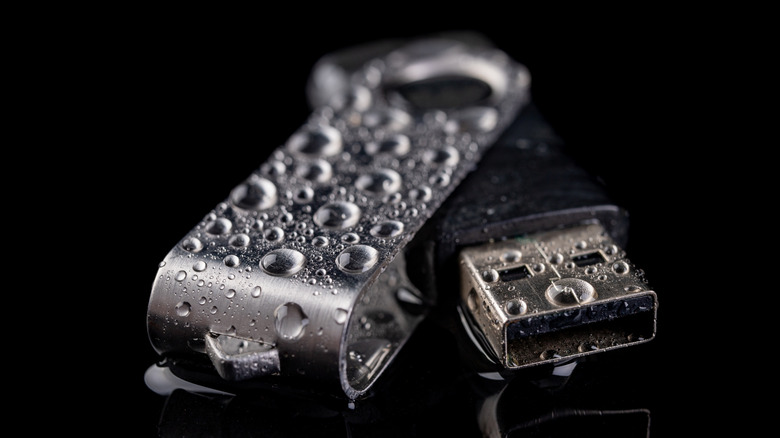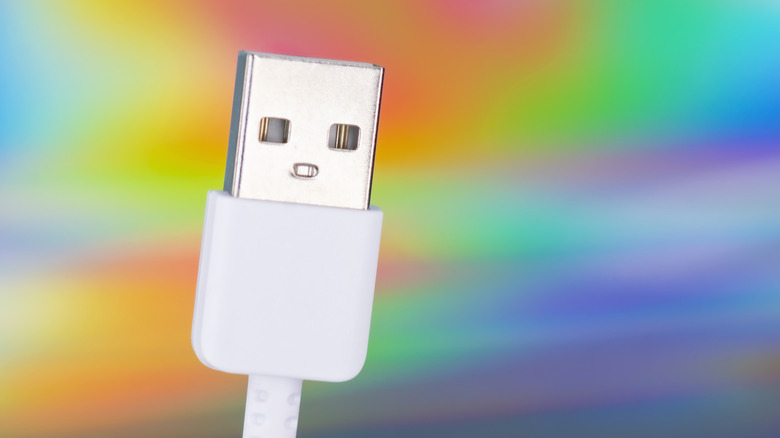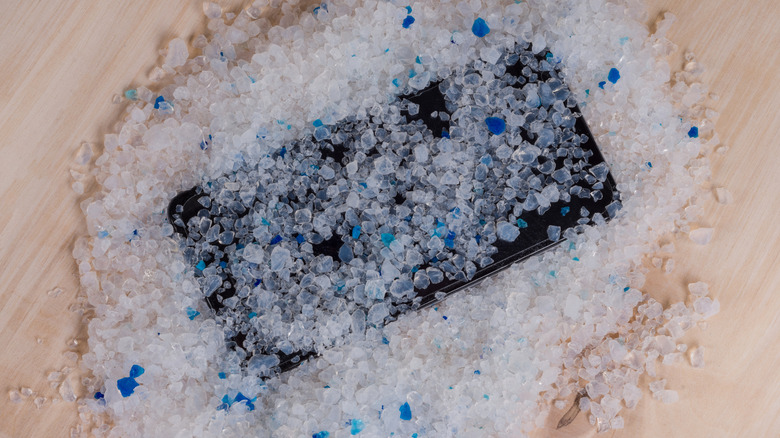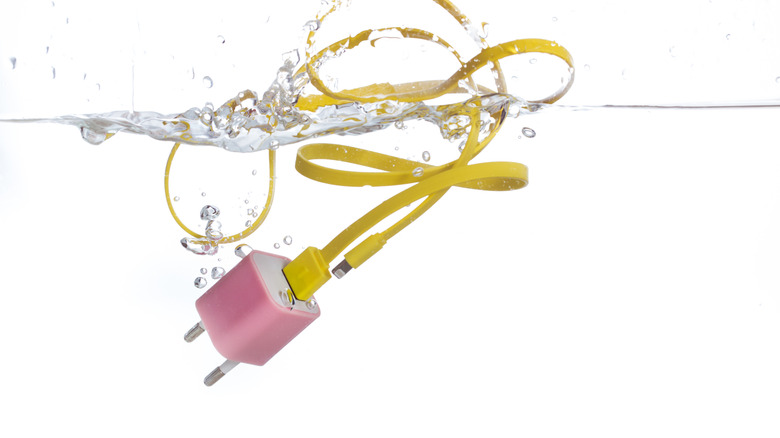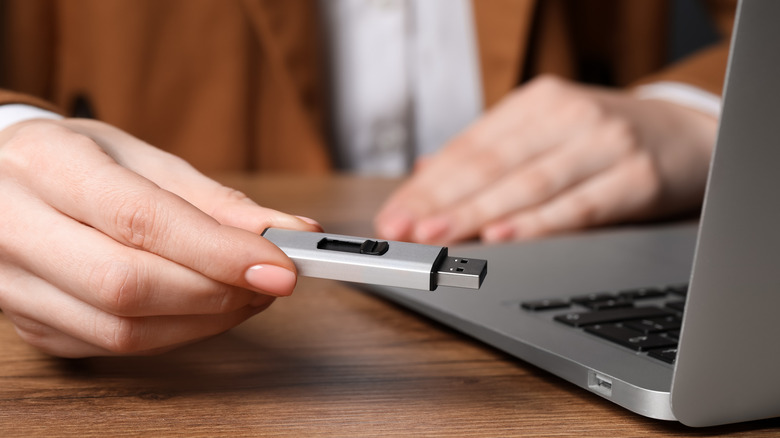Here's What To Do If You Get A USB Port, Drive, Or Cable Wet
USB ports and drives might not be waterproof, but accidents don't check spec sheets. Maybe you spilled a drink, got caught in the rain, or worse, your USB stick took an unplanned tumble in the washing machine. Whatever the case, a wet USB component isn't necessarily a goner, but what you do next makes all the difference.
The faster you act, the better. Water can corrode metal contacts, cause short circuits, or even permanently damage your device, so drying it out ASAP is crucial. But how you do it is just as important. In fact, it's the difference between a quick fix and a fried gadget. In these kinds of cases, panicking is not unusual, but rushing in with the wrong methods will only make things worse. Shaking your phone to get the water out or plugging in a damp cable might seem harmless, but these mistakes can seal your device's fate.
In this guide, we'll cover the safest ways to dry out a soaked USB port, drive, or cable, the common "fixes" that do more harm than good (spoiler: rice won't save your wet device), and how to prevent damage or data loss in the meantime.
What should be your first point of action?
The first port of call (pun definitely intended) is to immediately remove your device from the water. It sounds obvious, but panic scrambles logic, and every second counts. Get it out first, then focus on damage control.
Next, power it down immediately. If it's a phone, tablet, or any device with a battery, shut it off ASAP to prevent a short circuit. If it's a USB drive or cable, unplug it from any power source or device. Never check if it still works while wet — that's a one-way ticket to permanent failure.
Now, assess the situation. What kind of liquid was it? If it was anything other than fresh water (like soda, coffee, or saltwater), give the port, cable, or drive a quick rinse with fresh or distilled water before drying. It sounds counterintuitive, but sticky sugars or corrosive salts can do way more harm than a little extra clean water.
How to dry a wet USB port, drive, or cable
Now, onto drying. For mobile devices, tap gently against your hand with the port facing downward to shake out excess moisture. For a USB cable or drive, shake off excess water and place it on a dry, absorbent surface. In any case, resist the urge to shake a wet device vigorously in an attempt to get the water out. You'll only be helping it get even further inside. The same thing applies to blowing air into the soaked port or using hair dryers. Also, do not plug anything in — turning on a wet device is a fast track to frying it or, in the case of the USB drive, corrupting the data on it. Instead, set it in a well-ventilated area and let gravity do its thing. A fan can help, but avoid heat sources like hair dryers or direct sunlight, which can warp or damage internal components.
You'll need bucketloads of patience at this point. A USB port or drive can take anywhere from a few hours to a full day to dry completely — and it's risky to use it until then. Cables will typically dry faster, and you shouldn't have any reason to worry if the connector port stayed dry. If it got wet, follow the same drying process and only use it once you're sure it's dry. Most modern smartphones will show a Liquid Detected alert to let you know if the cable is still wet.
What not to do
There are plenty of ways to turn a wet device into a dead one, so knowing what not to do is just as important as knowing what to do. We've already covered the dangers of shaking, plugging in, and blowing air, but the list doesn't end there.
It might be tempting to reach for a cotton swab or paper towel to "soak up" the moisture inside a USB port. Don't. You'll likely push the water in deeper and risk damaging delicate wiring. Fibers or debris could also get lodged inside and make matters even worse.
And no, rice won't save your device—it's a stubborn tech myth, not a miracle cure. Studies have shown that air drying is just as effective, if not better. Rice grains can get lodged in ports, absorb moisture, and turn into a sticky, starchy mess.
Rubbing alcohol is another risky fix. While alcohol can displace water and evaporate quickly, it can also damage sensitive components like screens and camera lenses. Silica gel packets (the little pouches that come with new shoes and bags) are a much safer water-wicking medium. If you don't have any (or enough) on hand, they're easy to find at craft stores, hardware stores, or online. Just place your device in a sealed bag with a generous amount for several hours or overnight.
What to do if your USB drive won't work after drying
If your USB drive doesn't work after drying, data recovery might still be possible. First, try plugging it into another computer or port to rule out connection issues. If it's still unresponsive, avoid repeatedly plugging and unplugging—it could cause further damage.
For non-detectable drives, you can try using data recovery software like Recuva or EaseUS Data Recovery Wizard. These tools are designed to scan storage devices for lost or corrupted data, even if the drive doesn't show up in File Explorer or Finder.
Before running any recovery software, avoid formatting the drive or making unnecessary write attempts, as this can overwrite data and reduce the chances of recovery. Install the recovery tool on your computer (not the USB drive) and follow the instructions to scan for lost files. If the software detects your files, recover them to a different storage location to prevent further corruption.
If the drive is physically damaged and the software doesn't help, professional data recovery services might be your best bet. In the future, consider backing up important files and using a waterproof USB case. Prevention is always easier than recovery.
